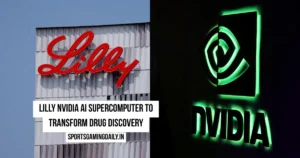The tech world was set abuzz when the NVIDIA Nokia AI partnership went public marking a major leap towards AI-native connectivity across 5G and 6G networks. In a move that grabbed attention beyond telecom circles, sportsgamingdaily readers and tech-enthusiasts alike saw this as the dawn of a new era in mobile networking. The deal brings together NVIDIA’s deep expertise in AI and accelerated computing with Nokia’s legacy in telecom infrastructure. Together, the NVIDIA Nokia AI partnership aims to build AI-native 5G 6G networks and reshape network architecture for years to come.
What the Deal Means
At its core, the NVIDIA Nokia AI partnership centres on how NVIDIA investment in Nokia to accelerate AI-RAN technology will play out. NVIDIA is investing $1 billion in Nokia in addition to forming a strategic alliance to create a next-generation radio access network for AI traffic. The investment gives NVIDIA roughly a 2.9 % stake in Nokia, underlining the depth of the commitment.
Through this collaboration, Nokia will produce new RAN solutions that can handle the explosion of AI-driven traffic expected in AI-native 5G 6G networks, while NVIDIA will provide the computing platform, including its new ARC-Pro design (its “Aerial RAN Computer Pro”) to support this shift.
With the deal signed, the “NVIDIA Nokia AI partnership” sets in motion how AI-native 5G 6G networks will evolve from concept to reality.
Why It’s a Game-Changer
First, the growth in mobile AI usage means networks must do more than carry bits: they must think. Under their joint initiative, the NVIDIA Nokia AI partnership will enable what companies call “AI-RAN” a radio access network that uses AI to manage traffic, optimize energy, reduce latency and deliver new services.
Second, the theme “How NVIDIA and Nokia will build AI-native 5G and 6G networks” comes into focus. By embedding accelerators and AI processing closer to the network edge, operators can serve new use-cases like drones, virtual-/augmented-reality glasses, autonomous vehicles and robots.
Third, economically the size of the opportunity is massive: analysts estimate the AI-RAN market could exceed US $200 billion by 2030.
So when you read about the “NVIDIA Nokia partnership telecom” platform being built, you’re really witnessing the foundation of the next wave in connectivity infrastructure.
Technical Highlights
The NVIDIA Nokia AI partnership will address several key technical dimensions of AI-native networks:
- The “NVIDIA ARC-Pro 6G RAN” concept: NVIDIA’s new hardware reference design that integrates connectivity, computing and sensing in a single platform for RAN use-cases.
- Nokia’s “anyRAN” strategy: Nokia will accelerate its existing AirScale baseband and Cloud RAN software to run on NVIDIA’s CUDA-based architecture, enabling a smooth transition from today’s 5G/5G-Advanced to true 6G.
- “Nokia AI-RAN investment” in software defined RAN evolution: Nokia will use the proceeds from NVIDIA’s investment to expand its AI & Cloud presence within its network infrastructure business.
- “Nokia and NVIDIA collaboration on radio access network for AI traffic”: By deploying AI-native features at the edge and combining them with high-performance compute, the partnership can address growing demands from generative AI and real-time applications.
Impact on Telecom Operators
For mobile network operators, the NVIDIA Nokia AI partnership telecom angle means they can start planning deployment of “AI-native 5G 6G networks” sooner rather than later. Because the architecture supports both existing 5G-Advanced and future 6G through software upgrades, operators can protect prior investments while preparing for the next frontier.
Additionally, operators will benefit from improved spectral and energy efficiency important as AI workloads grow at the edge. The network will evolve from ‘dumb pipe’ to a smart platform capable of hosting AI services, which in turn opens new revenue streams (edge-AI, sensing, private networks). The NVIDIA Nokia AI partnership adds real credibility to these shifts.
From a global leadership perspective, with this alliance, the companies aim to restore leadership in telecommunications infrastructure especially in the U.S. market.
Challenges and Considerations
Of course, building AI-native networks isn’t without hurdles. Some of the key questions the NVIDIA Nokia AI partnership must address:
- Cost-efficiency: Many in the industry are sceptical about deploying high-performance GPUs in RAN infrastructure due to cost.
- Software ecosystem readiness: Nokia must ensure its RAN software can be adapted to NVIDIA’s CUDA-based platform and maintain performance across heterogeneous hardware.
- Operator adoption: While the architecture is compelling, operators must see clear return-on-investment and be comfortable with integration, operations and maintenance of new AI-enabled systems.
- Global rollout: The deal is ambitious but trigger points such as regulatory, technical and standards alignment (especially for 6G) will influence how fast AI-native 5G 6G networks become mainstream.
The Future Outlook
When you look ahead, the story of the NVIDIA Nokia AI partnership is really about “The future of 6G: AI-native networks by NVIDIA and Nokia”. Within the next few years we should see early field trials (for instance with T‑Mobile US collaborating on testing) beginning around 2026.
As more devices use generative AI, augmented reality, sensing and real-time compute at the edge, the need for AI-native infrastructure becomes urgent. Thus the NVIDIA Nokia partnership telecom interest becomes not just a novelty but the backbone for many smart-city, industrial and consumer use-cases.
This shift will push telecom and cloud ecosystems closer together. Networks will not only carry data but also process and deliver intelligence locally. In that sense, how NVIDIA and Nokia will build AI-native 5G and 6G networks becomes a blueprint for the next decade of connectivity.
Why “sportsgamingdaily” Readers Should Care
Even if you follow “sportsgamingdaily” for game updates and e-sports, this deal matters. The same networks supporting high-frame-rate cloud-gaming, extended reality experiences, esports arenas and immersive social platforms will soon rely on AI-native 5G/6G. The NVIDIA Nokia AI partnership means faster, smarter, more reliable connections which gamers and sports-viewers will appreciate. When your virtual reality headset streams real-time action or when an e-sports event uses AI to optimise latency, the infrastructure built under this partnership will be underpinning it.
Conclusion
In short, the NVIDIA Nokia AI partnership marks one of the most important alliances in telecommunications for years. It brings together AI compute, telecom gear and future-ready networking under a unified vision of AI-native 5G 6G networks. With the NVIDIA investment in Nokia to accelerate AI-RAN technology, and Nokia’s radio access network for AI traffic collaboration with NVIDIA, the stage is set. As networks evolve, the promise is not just more speed but smarter connectivity. For readers of sportsgamingdaily and anyone interested in the next wave of mobile tech, this is one to watch.










